True Tales of Tribeca’s Buildings
The History of Tribeca Buildings database—compiled from Tom Miller’s posts at Daytonian in Manhattan—has five more entries on the properties below. (Click the address to read the full text.) If you enjoy these, and you will, then you should definitely check out his website, which also has write-ups about buildings all over the island. And don’t miss his book, Seeking New York: The Stories Behind the Historic Architecture of Manhattan—One Building at a Time.
··················
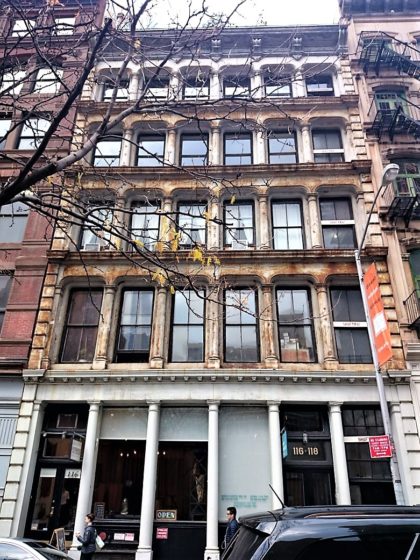 116-118 FRANKLIN
116-118 FRANKLIN
A traveling salesman for J. L. Brown, Walter W. Walsh worked late on January 24 1896, unnoticed by coworkers who one by one went home. When he tried to leave, he discovered that he was locked inside the building. Late in the night a policeman passing the building heard a tapping noise inside. Then, according to The Sun, a man’s voice yelled, “Say, help me get out, will you? I’ve been locked in.” Suspecting that he may be communicating with a burglar, the cop interviewed him through the iron door for some time before finding a ladder and managing his release. Nevertheless, Walsh was taken to the station house until his identity was firmly established.
··················
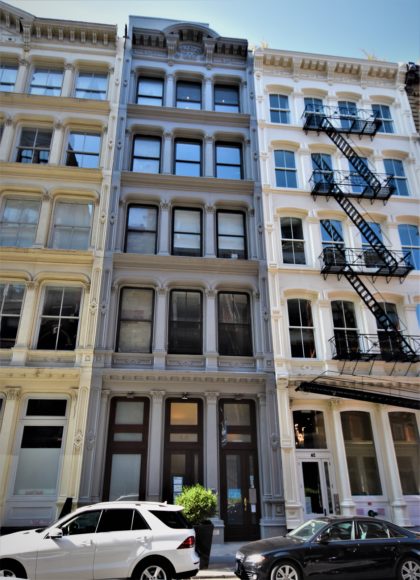 44 LISPENARD
44 LISPENARD
Not long after New York’s labor force returned from fighting in the South, a building boom engulfed the Tribeca area, as vintage homes and shops were replaced by tall loft buildings. Among the most prolific of the architects working in the area was Isaac F. Duckworth, who routinely made use of the increasingly popular cast-iron facades. In 1866, he was hired by Emanuel Ehlfelder to design a five-story structure on the site of a one-story brick building at No. 44 Lispenard Street. Duckworth turned to the relatively new French Second Empire style for the building, completed in 1867. Interestingly, he would recycle the foundry molds, creating identical structures at No. 315-317 Church Street, No. 54 Lispenard Street, and No. 38 Lispenard Street.
··················
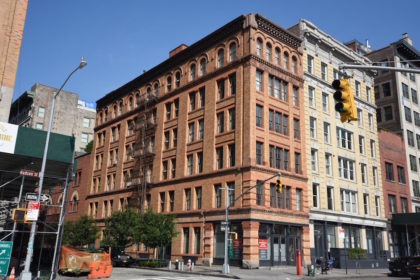 151 HUDSON
151 HUDSON
As its new building at 151 Hudson rose, Aspell & Co. was operating from Nos. 314-316 Greenwich Street. The wholesale grocery dealers embarked on an unusual marketing scheme that year. It opened a new department that offered certain items at wholesale prices to individual shoppers—a savings of up to 50 percent. An advertisement on August 19, 1894, promised the housekeeper that on top of the savings, she could have “the goods delivered free of charge in or out of the city” (foreshadowing by more than a century retail giants like Amazon). There was “a full line of staple and fancy groceries and wines, etc., also table delicacies suitable for city, country or seaside use.”
··················
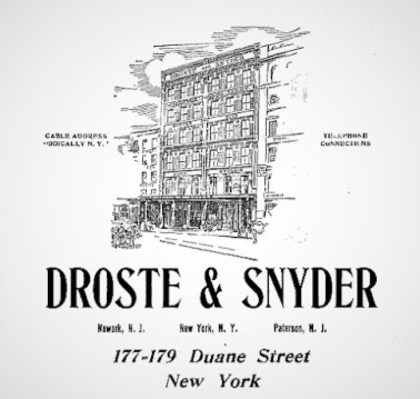 177-179 DUANE
177-179 DUANE
After the building was completed in 1885, it became home to Clark, Chapin & Bushnell, wholesale grocers. By the turn of the century, labor unions were gaining power, and the disparate interests of workers and management sometimes boiled over into ugly and violent clashes. When teamsters went on strike in December, 1905, Clark, Chapin & Bushnell refused to give in to their demands. They simply fired those on strike and hired new drivers. Recognizing the potential of danger to its new employees, the firm put an armed guard on each truck. Early in March, 1906, the strike seemed to have been settled, and the guards were released. The union men then launched a series of attacks, landing ten drivers in the hospital, one of whom would not survive. In that case, a gang jumped onto his truck, beat him with heavy cotton bale hooks until he was unconscious, then threw his body into the street. Then, at around 4:15 a.m. on March 14, a massive explosion occurred at the Duane Street building. “The entire shipping department was destroyed by the explosion,” reported the New York Times. “The dynamite was thrown through a door opening on the street, the wire screen to which was wrenched off on Monday night and the glass panel broken.” The Evening World said, “The vibration was so great that it was heard for a radius of half a mile.” It was the first of three attempts to bomb the building.
··················
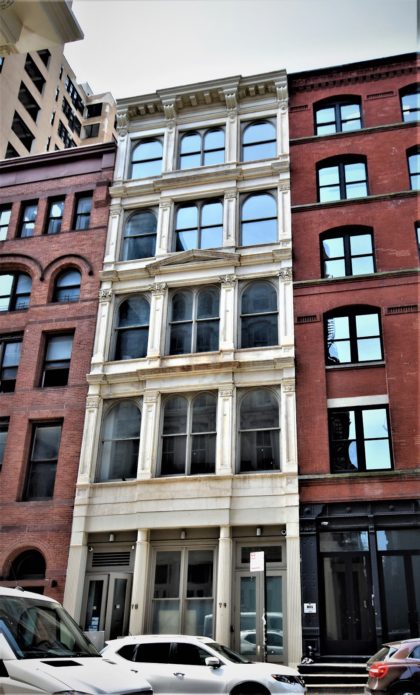 79 WHITE
79 WHITE
Although the 25-foot wide building would not be officially completed until 1862, the Government could not wait that long. On April 12, 1861, the first shot was fired that sparked Civil War. By the end of summer, No. 79 White Street was filled with uniformed officers organizing the newly-recruited Union soldiers. On August 23, The New York Times announced, “Commandants of all regiments accepted by the War Department are requested to call upon Lieut.-Col. D. B. Sacket, at the mustering office, 79 White-st., where he will explain to them all the provisions made by the Department, for facilitating the collection, subsistence and transportation of recruits.” The building was also used as an interim barracks for northern units traveling to the front. In January, 1862, for instance, the 1,046 men of the New-Hampshire Seventh Regiment were quartered here awaiting further orders.
··················













